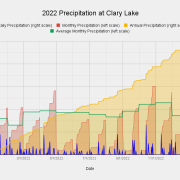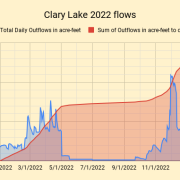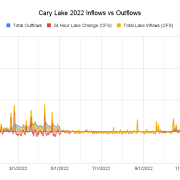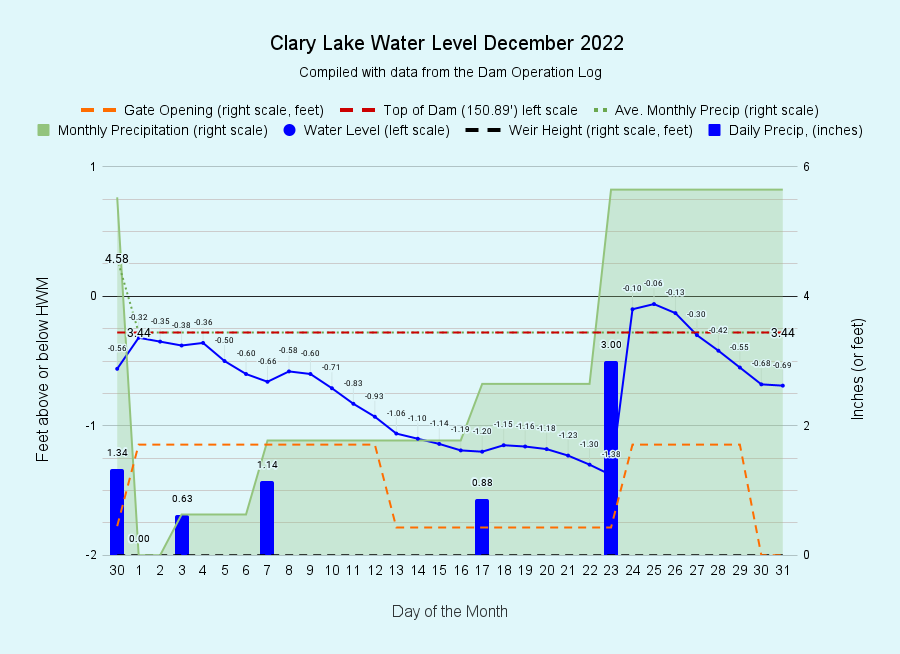And that’s a wrap! I have archived the December water level chart (at left) bringing 2022 to a close. I guess the most impressive thing about December had to be the huge 24 hour lake level rise of 15.8″ from just 3″ of rain (and a little snow melt) on the day before Christmas for a runoff multiplier of over 5X. You can see excessive runoff this time of year because frozen ground means more rain runs off and less soaks into the ground. We’ve seen some big lake level responses to rainfall, but this is one of the biggest I can remember in a long time.
The lake would have risen a whole lot more had we not fully opened the gate on Saturday morning, increasing outflows to a little over 100 cfs, enough to effectively halt the lake level rise and start it going in the other direction. Six days later, after the lake had fallen some, we fully closed the gate and leaving the weir wide open, cutting outflows to a more reasonable 30 cfs. This should provide sufficient outflows to let the lake level slowly fall as winter continues. We’d like to see the lake level a little lower going into winter, but this year, Mother Nature didn’t cooperate.
 That 3″ of rain on the 23rd brought us to 5.65″ for the month, 2.21″ more than the normal 3.44″ for December (see the precipitation chart at left). As such, we ended the year with 49.94″ of precipitation, fully 5.88″ above the normal annual rainfall amount of 44.06 inches which not bad considering we actually had below average monthly rainfall in March, May, June, and July. We sure made up for those 4 short months! Ground water supplies have been replenished.
That 3″ of rain on the 23rd brought us to 5.65″ for the month, 2.21″ more than the normal 3.44″ for December (see the precipitation chart at left). As such, we ended the year with 49.94″ of precipitation, fully 5.88″ above the normal annual rainfall amount of 44.06 inches which not bad considering we actually had below average monthly rainfall in March, May, June, and July. We sure made up for those 4 short months! Ground water supplies have been replenished.
 Hydrologically speaking, 2022 was a pretty bizarre year and I have 2 charts which illustrate this nicely. The chart at left shows daily outflows from Clary Lake and accumulated outflows, in acre-feet (an acre-foot of water is one acre of water one foot deep or 43,560 cubic feet; when completely full, Clary Lake contains 7,224 acre-feet of water). The chart shows that starting around May 1st, outflows dropped to almost nothing and didn’t start to pick up again until October. At the same time, we lost 1.5 feet of water from the lake, mostly due to evaporation which served to concentrate nutrients, primarily Phosphorus and Nitrogen. In short, Clary Lake became a stagnant pool, perfect conditions to promote the growth of algae. It is not surprising therefore that these conditions resulted in a severe algae bloom of blue-green algae (Cyanobacteria) that started in very early September went on for over two and a half months. I wrote about this several times this past fall (see 27 September 2022: Cyanobacteria in Clary Lake).
Hydrologically speaking, 2022 was a pretty bizarre year and I have 2 charts which illustrate this nicely. The chart at left shows daily outflows from Clary Lake and accumulated outflows, in acre-feet (an acre-foot of water is one acre of water one foot deep or 43,560 cubic feet; when completely full, Clary Lake contains 7,224 acre-feet of water). The chart shows that starting around May 1st, outflows dropped to almost nothing and didn’t start to pick up again until October. At the same time, we lost 1.5 feet of water from the lake, mostly due to evaporation which served to concentrate nutrients, primarily Phosphorus and Nitrogen. In short, Clary Lake became a stagnant pool, perfect conditions to promote the growth of algae. It is not surprising therefore that these conditions resulted in a severe algae bloom of blue-green algae (Cyanobacteria) that started in very early September went on for over two and a half months. I wrote about this several times this past fall (see 27 September 2022: Cyanobacteria in Clary Lake).
 While the above chart shows flows in acre-feet the chart at left shows those flows in cubic feet per second, and the message is the same: the flat blue line depicting outflows from May through September and the lack of any inflows to speak of during that same period tells the story. The sad thing is there is nothing we could have done to change what happened last summer. We only have 2 feet to play with and we had no choice but to shut down outflows in May and try to preserve what water we had in the lake until fall rains arrived. When they finally did arrive, it was too late to make any difference. It is surprising considering how dry the summer was that we actually ended the year with close to six inches of precipitation above the annual norm. Unusual indeed.
While the above chart shows flows in acre-feet the chart at left shows those flows in cubic feet per second, and the message is the same: the flat blue line depicting outflows from May through September and the lack of any inflows to speak of during that same period tells the story. The sad thing is there is nothing we could have done to change what happened last summer. We only have 2 feet to play with and we had no choice but to shut down outflows in May and try to preserve what water we had in the lake until fall rains arrived. When they finally did arrive, it was too late to make any difference. It is surprising considering how dry the summer was that we actually ended the year with close to six inches of precipitation above the annual norm. Unusual indeed.
I should launch into a discussion of the final 2022 Flushing Rate (1.87X) and Retention time (194 days) but this post is already long enough, if not too long. You’ll find these and other charts in the 2022 Water Level Charts Archive. There is also a new 2023 Dam Operation Log in place.
I know 2022 was a harsh toke for a lot of people, it was for me, for a variety of reasons, and I know many of you have also faced challenges this past year that you’d rather put behind you, or forget completely. Here’s wishing everyone a peaceful and smooth transition to a healthy and prosperous New Year. I’ll leave you with the Fergusson Clan Moto: “Dulcius ex asperis” which means Sweeter After Difficulty.

